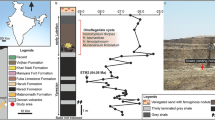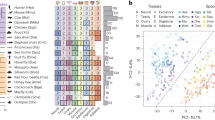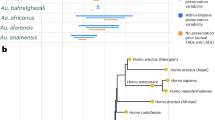Abstract
Molecular estimates of the divergence of placental and marsupial mammals and their broader clades (Eutheria and Metatheria, respectively) fall primarily in the Jurassic period. Supporting these estimates, Juramaia—the oldest purported eutherian—is from the early Late Jurassic (160 million years ago) of northeastern China. Sinodelphys—the oldest purported metatherian—is from the same geographic area but is 35 million years younger, from the Jehol biota. Here we report a new Jehol eutherian, Ambolestes zhoui, with a nearly complete skeleton that preserves anatomical details that are unknown from contemporaneous mammals, including the ectotympanic and hyoid apparatus. This new fossil demonstrates that Sinodelphys is a eutherian, and that postcranial differences between Sinodelphys and the Jehol eutherian Eomaia—previously thought to indicate separate invasions of a scansorial niche by eutherians and metatherians—are instead variations among the early members of the placental lineage. The oldest known metatherians are now not from eastern Asia but are 110 million years old from western North America, which produces a 50-million-year ghost lineage for Metatheria.
This is a preview of subscription content, access via your institution
Access options
Access Nature and 54 other Nature Portfolio journals
Get Nature+, our best-value online-access subscription
$29.99 / 30 days
cancel any time
Subscribe to this journal
Receive 51 print issues and online access
$199.00 per year
only $3.90 per issue
Buy this article
- Purchase on Springer Link
- Instant access to full article PDF
Prices may be subject to local taxes which are calculated during checkout





Similar content being viewed by others
References
Zhou, Z. & Wang, Y. Vertebrate diversity of the Jehol Biota as compared with other lagerstätten. Sci. China Earth Sci. 53, 1894–1907 (2010).
Ji, Q. et al. The earliest known eutherian mammal. Nature 416, 816–822 (2002).
Hu, Y., Meng, J., Li, C. & Wang, Y. New basal eutherian mammal from the Early Cretaceous Jehol biota, Liaoning, China. Proc. R. Soc. Lond. B 277, 229–236 (2010).
Wible, J. R., Rougier, G. W., Novacek, M. J. & Asher, R. J. The eutherian mammal Maelestes gobiensis from the Late Cretaceous of Mongolia and the phylogeny of Cretaceous Eutheria. Bull. Am. Mus. Nat. Hist. 327, 1–123 (2009).
Luo, Z.-X., Yuan, C.-X., Meng, Q.-J. & Ji, Q. A Jurassic eutherian mammal and divergence of marsupials and placentals. Nature 476, 442–445 (2011).
O’Leary, M. A. et al. The placental mammal ancestor and the post-K-Pg radiation of placentals. Science 339, 662–667 (2013).
Luo, Z.-X., Ji, Q., Wible, J. R. & Yuan, C.-X. An Early Cretaceous tribosphenic mammal and metatherian evolution. Science 302, 1934–1940 (2003).
Chang, S.-C., Gao, K.-Q., Zhou, C.-F. & Jourdan, F. New chronostratigraphic constraints on the Yixian Formation with implications for the Jehol Biota. Palaeogeogr. Palaeoclimatol. Palaeoecol. 487, 399–406 (2017).
Williamson, T. E., Brusatte, S. L. & Wilson, G. P. The origin and early evolution of metatherian mammals: the Cretaceous record. ZooKeys 465, 1–76 (2014).
Bi, S., Jin, X., Li, S. & Du, T. A new Cretaceous metatherian mammal from Henan, China. PeerJ 3, e896 (2015).
Averianov, A. O. & Archibald, D. in Legacy of the Gobi Desert: Papers in Memory of Zofia Kielan-Jaworowska (Palaeontologia Polonica 67) (eds Cifelli, R. L. & Fostowicz-Frelik, Ł.) 25–33 (Institute of Paleobiology of the Polish Academy of Sciences, Warsaw, 2016).
Kusuhashi, N. et al. A new Early Cretaceous eutherian mammal from the Sasayama Group, Hyogo, Japan. Proc. R. Soc. Lond. B 280, 20130142 (2013).
Cifelli, R. L. Tribosphenic mammal from the North American Early Cretaceous. Nature 401, 363–366 (1999).
Sweetman, S. C., Smith, G. & Martill, D. M. Highly derived eutherian mammals from the earliest Cretaceous of southern Britain. Acta Palaeontol. Pol. 62, 657–665 (2017).
Kermack, K. A., Lees, P. M. & Mussett, F. Aegialodon dawsoni, a new trituberculosectorial tooth from the Lower Wealden. Proc. R. Soc. Lond. B 162, 535–554 (1965).
Davis, B. M., Cifelli, R. L. & Kielan-Jaworowska, Z. in Mammalian Evolutionary Morphology: a Tribute to Frederick S. Szalay (eds Sargis, E. J. & Dagosto, M.) 3–24 (Springer, Dordrecht, 2008).
Cifelli, R. L. & Davis, B. M. Tribosphenic mammals from the Lower Cretaceous Cloverly Formation of Montana and Wyoming. J. Vertebr. Paleontol. 35, e920848 (2015).
Averianov, A. O., Archibald, J. D. & Ekdale, E. G. New material of the Late Cretaceous deltatheroidan mammal Sulestes from Uzbekistan and phylogenetic reassessment of the metatherian–eutherian dichotomy. J. Syst. Palaeontol. 8, 301–330 (2010).
Szalay, F. S. & Trofimov, B. A. The Mongolian Late Cretaceous Asiatherium, and the early phylogeny and paleobiogeography of Metatheria. J. Vertebr. Paleontol. 16, 474–509 (1996).
Kielan-Jaworowska, Z. in Results of the Polish–Mongolian Palaeontological Expeditions. Part IX. (Palaeontologia Polonica 42) (ed. Kielan-Jaworowska, Z.) 25–78 (Institute of Paleobiology of the Polish Academy of Sciences, Warsaw, 1981).
McKenna, M. C., Kielan-Jaworowska, Z. & Meng, J. Earliest eutherian mammal skull from the Late Cretaceous (Coniacian) of Uzbekistan. Acta Palaeontol. Pol. 45, 1–54 (2000).
Wible, J. R., Novacek, M. J. & Rougier, G. W. New data on the skull and dentition in the Mongolian Late Cretaceous eutherian mammal Zalambdalestes. Bull. Am. Mus. Nat. Hist. 281, 1–144 (2004).
Meng, J., Wang, Y. & Li, C. Transitional mammalian middle ear from a new Cretaceous Jehol eutriconodont. Nature 472, 181–185 (2011).
Luo, Z.-X. Developmental patterns in Mesozoic evolution of mammal ears. Annu. Rev. Ecol. Evol. Syst. 42, 355–380 (2011).
Ramírez-Chaves, H. E. et al. Mammalian development does not recapitulate suspected key transformations in the evolutionary detachment of the mammalian middle ear. Proc. R. Soc. Lond. B 283, 20152606 (2016).
Gasc, J.-P. in Traité de Zoologie tome XVI, fasc. 1 (ed. Grassé, P.-P.) 550–583, 1103–1106 (Masson, Paris, 1971).
Standring, S. (ed.) Gray’s Anatomy: the Anatomical Basis of Clinical Practice 40th edn (Churchill Livingstone, Edinburgh, 2008).
Rougier, G. W., Ji, Q. & Novacek, M. J. A new symmetrodont mammal with fur impressions from the Mesozoic of China. Acta Geol. Sin. 77, 7–14 (2003).
Luo, Z.-X. et al. New evidence for mammaliaform ear evolution and feeding adaptation in a Jurassic ecosystem. Nature 548, 326–329 (2017).
Hoffmeister, R. G. & Hoffmeister, D. F. The hyoid in North American squirrels, Sciuridae, with remarks on associated musculature. An. Inst. Biol. Univ. Nac. Auton. Mex. Ser. Zool. 62, 219–234 (1991).
Chen, M. & Wilson, G. P. A multivariate approach to infer locomotor modes in Mesozoic mammals. Paleobiology 41, 280–312 (2015).
Meredith, R. W. et al. Impacts of the Cretaceous terrestrial revolution and KPg extinction on mammal diversification. Science 334, 521–524 (2011).
dos Reis, M. et al. Phylogenomic datasets provide both precision and accuracy in estimating the timescale of placental mammal phylogeny. Proc. R. Soc. Lond. B 279, 3491–3500 (2012).
Meng, J. Mesozoic mammals of China: implications for phylogeny and early evolution of mammals. Natl Sci. Rev. 1, 521–542 (2014).
Goloboff, P. A., Farris, J. S. & Nixon, K. C. TNT, a free program for phylogenetic analysis. Cladistics 24, 774–786 (2008).
Acknowledgements
We thank S. Xie for specimen preparation; P. Bowden for illustration; W. Gao for photography; Y. Hou and P. Yin for computed tomography scanning; D. Koyabu and V. Weisbecker for providing the computed tomography dataset of Monodelphis; and J. Meng, X. Xu, B. Jiang and Y. Huang for assistance and discussion. The study was supported by the National Natural Science Foundation of China (41688103, 41728003, 41372014, 41472023) and Chinese Academy of Sciences (XDPB0503). Support for S.B. was provided by the MEC International Joint Laboratory for Palaeobiology and Palaeoenvironment, Yunnan University. Support for J.R.W. is provided by the National Science Foundation Grant DEB 1654949 and Carnegie Museum of Natural History.
Reviewer information
Nature thanks R. Cifelli, D. Krause and G. Rougier for their contribution to the peer review of this work.
Author information
Authors and Affiliations
Contributions
S.B. and J.R.W. conceived the study, undertook comparative and analytical work and wrote the paper; N.E.C. performed the ternary plot; and X.Z., S.Y. and X.W. contributed to fossil interpretation and provided feedback to the paper.
Corresponding authors
Ethics declarations
Competing interests
The authors declare no competing interests.
Additional information
Publisher’s note: Springer Nature remains neutral with regard to jurisdictional claims in published maps and institutional affiliations.
Extended data figures and tables
Extended Data Fig. 1 Line drawings of A. zhoui STM33-5.
a, Main slab. b, Counterpart slab.
Extended Data Fig. 2 Close-up views of craniodental features of A. zhoui STM33-5.
a, Partial skull and left dentary of the main slab in lateral view. b, Partial skull and right dentary of the counterpart slab in medial view. M and m, upper and lower molars, respectively; P and p, upper and lower premolars, respectively. ch, choanae; ec, ectotympanic; end, entoconid; fm, foramen magnum; hyld, hypoconulid; iof, infraorbital foramen; ju, jugal; mf, mental foramina; mfo, masseteric foramen; oc, occipital condyle; ppt, postpalatine torus; pr, promontorium of petrosal.
Extended Data Fig. 3 Left upper and lower teeth of A. zhoui STM33-5 as preserved on the main slab (A) of the specimen from 3D rendering (Mimics) of computed tomography scans.
a, Buccal view. b, Lingual view. c, Occlusal view. The lingual face of M1–M3, including the entoconid and hypoconulid, has been sheared off.
Extended Data Fig. 5 Left upper dentition of Sinodelphys szalayi.
a, Dental formula redrawn from a previous study7. b, Dental formula proposed in this work on drawing of CM 79002 (a cast of the holotype). Note that the tooth identified as M1 in the previous study7 is not molariform, but is instead built on the same pattern as the tall, trenchant premolariform tooth that is mesial to it. On the M1 and M2 (as interpreted here), the paracone and metacone are hidden by the stylar shelf.
Extended Data Fig. 6 The strict consensus tree of four equally most-parsimonious trees.
The consensus tree length = 1,779, consistency index = 0.318 and retention index = 0.597. A simplified version of this consensus tree is presented in Fig. 4.
Extended Data Fig. 7 Analysis of limb elements of A. zhoui STM33-5 for locomotor behaviour.
a, Ternary plot showing intrinsic manual ray III proportions. b, Box plots of the intermembral index. The line that divides the box into two parts represents the median, the box shows the upper and lower quartiles, and the whiskers show extreme values for each group.
Supplementary information
Supplementary Information
This file contains Supplementary Information Part A-H which contains Tables 1-2
Rights and permissions
About this article
Cite this article
Bi, S., Zheng, X., Wang, X. et al. An Early Cretaceous eutherian and the placental–marsupial dichotomy. Nature 558, 390–395 (2018). https://doi.org/10.1038/s41586-018-0210-3
Received:
Accepted:
Published:
Issue Date:
DOI: https://doi.org/10.1038/s41586-018-0210-3
This article is cited by
-
Zoonotic Cryptosporidium and Giardia in marsupials—an update
Parasitology Research (2024)
-
Middle ear innovation in Early Cretaceous eutherian mammals
Nature Communications (2023)
-
Jaw shape and mechanical advantage are indicative of diet in Mesozoic mammals
Communications Biology (2021)
-
New Specimens of Reigitherium bunodontum from the Late Cretaceous La Colonia Formation, Patagonia, Argentina and Meridiolestidan Diversity in South America
Journal of Mammalian Evolution (2021)
-
The Cranial Morphospace of Extant Marsupials
Journal of Mammalian Evolution (2021)
Comments
By submitting a comment you agree to abide by our Terms and Community Guidelines. If you find something abusive or that does not comply with our terms or guidelines please flag it as inappropriate.



